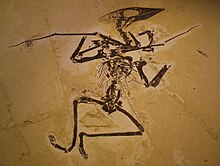
Tapejara is a genus of Brazilian pterosaur from the Cretaceous Period. Tapejara crests consisted of a semicircular crest over the snout, and a bony prong which extended back behind the head. It was a small pterosaur, with a wingspan of approximately 1.23–1.3 metres (4.0–4.3 ft).

Azhdarchidae is a family of pterosaurs known primarily from the Late Cretaceous Period, though an isolated vertebra apparently from an azhdarchid is known from the Early Cretaceous as well. Azhdarchids are mainly known for including some of the largest flying animals discovered, but smaller cat-size members have also been found. Originally considered a sub-family of Pteranodontidae, Nesov (1984) named the Azhdarchinae to include the pterosaurs Azhdarcho, Quetzalcoatlus, and Titanopteryx. They were among the last known surviving members of the pterosaurs, and were a rather successful group with a worldwide distribution. Previously it was thought that by the end of the Cretaceous, most pterosaur families except for the Azhdarchidae disappeared from the fossil record, but recent studies indicate a wealth of pterosaurian fauna, including pteranodontids, nyctosaurids, tapejarids and several indeterminate forms.

Tupuxuara is a genus of thalassodromid pterosaur that lived during the Albian age of the Early Cretaceous, about 112 million years ago. Its remains were found in what is now the Romualdo Formation of the Santana Group in Brazil. Tupuxuara was named in 1988 by paleontologists Alexander Kellner and Diógenes de Almeida Campos. The name Tupuxuara means "familiar spirit" referring to a familiar spirit in the mythology of the Tupi people in Brazil. Two species have been named, T. longicristatus, the type species, and T. leonardii. An additional species has been named in 2013, T. deliradamus. However, the validity of this species has been put into question and it may not even belong to Tupuxuara.

Thalassodromeus is a genus of pterosaur that lived in what is now Brazil during the Early Cretaceous period, about a hundred million years ago. The original skull, discovered in 1983 in the Araripe Basin of northeastern Brazil, was collected in several pieces. In 2002, the skull was made the holotype specimen of Thalassodromeus sethi by palaeontologists Alexander Kellner and Diogenes de Almeida Campos. The generic name means "sea runner", and the specific name refers to the Egyptian god Seth due to its crest being supposedly reminiscent of Seth's crown. Other scholars have pointed out that the crest was instead similar to the crown of Amon. A jaw tip was assigned to T. sethi in 2005, became the basis of the new genus Banguela in 2015, and assigned back to Thalassodromeus as the species T. oberlii in 2018, though other researchers consider it a valid genus. Another species was described in 2015 based on a supposed crest fragment, but this was later shown to be part of a turtle shell.
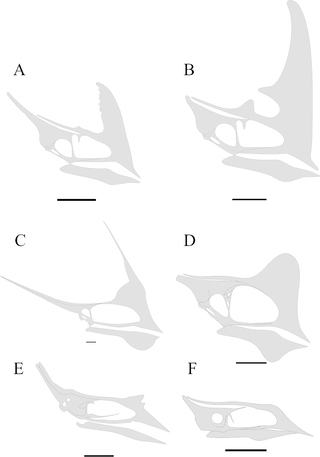
Tapejaridae are a family of pterodactyloid pterosaurs from the Cretaceous period. Members are currently known from Brazil, England, Hungary, Morocco, Spain, the United States, and China. The most primitive genera were found in China, indicating that the family has an Asian origin.
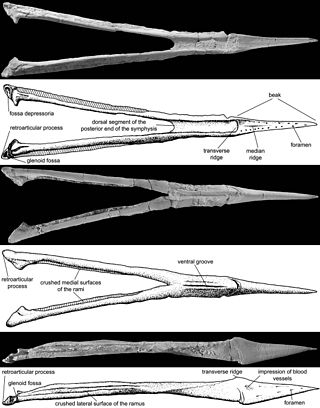
Bakonydraco is a genus of pterodactyloid pterosaur from the Late Cretaceous period of what is now the Csehbánya Formation of the Bakony Mountains, Iharkút, Veszprém, western Hungary.
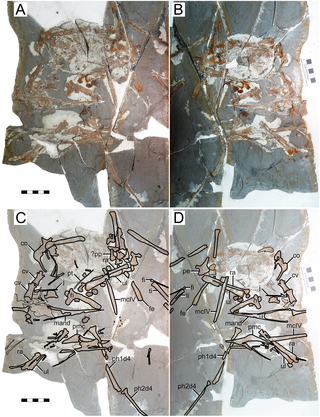
Eopteranodon is a genus of tapejarid pterosaur from the Aptian-age Lower Cretaceous Yixian Formation of Beipiao City, Liaoning, China. The genus was named in 2005 by paleontologists Lü Junchang and Zhang Xingliao. The type species is Eopteranodon lii. A second species, E. yixianensis, was named in 2023, but its validity has been questioned.

Sinopterus is a genus of tapejarid pterodactyloid pterosaur from the Aptian-age Lower Cretaceous Jiufotang Formation of Chaoyang, Liaoning, China. It was first described and named by Wang Xiaolin and Zhou Zhonghe. Historically, there were multiple species attributed to the genus although only one is considered to be valid. Sinopterus is known for its proportionally large skull, which has a birdlike pointed beak, a long bony crest that starts with a tall premaxilla and goes back along the middle of the skull to form a point overhanging the rear of the skull, and its lack of teeth.

Azhdarchoidea is a group of pterosaurs within the suborder Pterodactyloidea, more specifically within the group Ornithocheiroidea. Pterosaurs belonging to this group lived throughout the Early and Late Cretaceous periods, with one tentative member, Tendaguripterus, that lived in the Late Jurassic period. The largest azhdarchoids include members of the family Azhdarchidae, examples of these are Quetzalcoatlus, Hatzegopteryx, and Arambourgiania. Other notable pterosaur families belonging to the Azhdarchoidea are the Tapejaridae, the Thalassodromidae, and the Chaoyangopteridae. This group contains some of the most advanced members of the pterosaur order.

Tupandactylus is a genus of tapejarid pterodactyloid pterosaur from the Early Cretaceous Crato Formation of Brazil.

Chaoyangopteridae is a family of pterosaurs within the larger group Azhdarchoidea. Chaoyangopterids lived mostly during the Early Cretaceous period, though possible members, Microtuban, Xericeps and Argentinadraco, may extend the fossil range to the Late Cretaceous.

Thalassodromidae is a group of azhdarchoid pterosaurs from the Cretaceous period. Its traditional members come from Brazil, which include the type genus Thalassodromeus, as well as Tupuxuara. Additionally, the recently named genus Kariridraco, also from Brazil, is another undisputed thalassodromid. However, other possible members also come from other places, including Morocco and Argentina.

Aerotitan is a genus of azhdarchid pterosaur that lived during the Maastrichtian age of the Late Cretaceous period in what is now Argentina. Its only remains, which consist of a partial snout, were found in the Allen Formation of the Neuquén Basin in northern Patagonia. This specimen was made the holotype of Aerotitan sudamericanus by paleontologist Fernando Novas and colleagues. The generic name combines the Greek word ἀήρ, meaning "air" and Titan, alluding to the pterosaur's large size. The specific name is a reference to its origin, South America.

Vectidraco, is a genus of azhdarchoid pterosaur from the Lower Cretaceous of England.
Alamodactylus is an extinct genus of pteranodontian pterosaur known from the Late Cretaceous of Texas, southern United States. It contains a single species, Alamodactylus byrdi.

Tapejaroidea is a group of pterosaurs belonging to the clade Ornithocheiroidea. Tapejaroids lived from the Early to Late Cretaceous periods, with one possible member, Tendaguripterus, extending the fossil range to the Late Jurassic period. Tapejaroidea contains two groups, the Dsungaripteridae and the Azhdarchoidea, which in turn includes the azhdarchids, the group that contains some of the largest flying animals. The group was named by Brazilian paleontologist Alexander Wilhelm Armin Kellner in 1996.
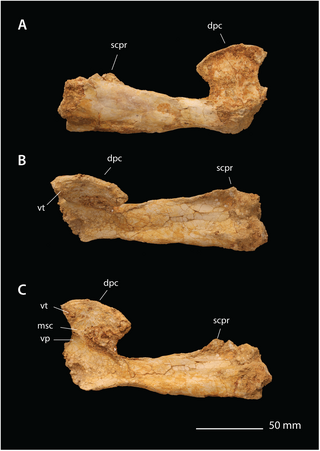
Simurghia is a genus of pterosaur from the Ouled Abdoun Basin of Morocco, a basin that dates to the Maastrichtian stage of the Late Cretaceous period, about 66 million years ago. It was published in 2018 by paleontologists Nicholas R. Longrich, David M. Martill, and Brian Andres, along with two other pterosaurs from the same basin: Alcione and Barbaridactylus. The type species is S. robusta. A possible second species, S. ("Nyctosaurus") lamegoi, is known from the Campanian-Maastrichtian age strata of Brazil.
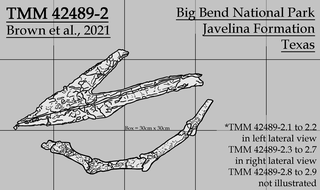
Wellnhopterus is a genus of azhdarchid pterosaur that lived during the Maastrichtian age of the Late Cretaceous period in what us now Texas, United States. Its fossil remains were discovered in the Javelina Formation at Big Bend National Park, located in Brewster County, Texas. The fossils consist of a set of upper and lower jaws, several cervical (neck) vertebrae, and a fragmentary long bone. Originally referred to an indeterminate species of Quetzalcoatlus, these remains would receive various interpretations ranging from a tapejarid to an azhdarchid identity. It was not until December 2021 that they were given a new genus and type species, Wellnhopterus brevirostris, named and described by paleontologists Brian Andres and, posthumously, Wann Langston Jr.. Its generic name means "Wellnhofer's wing", named in honor of paleontologist Peter Wellnhofer, while its specific name means "short-beaked", attributing to the blunt structure of its jaws.

Huaxiadraco is a genus of tapejarid pterodactyloid pterosaur from the Aptian-age Lower Cretaceous Jiufotang Formation of Chaoyang, Liaoning, China. It is the third valid genus of tapejarid from the Jehol Biota, after Sinopterus and Eopteranodon. It contains one species, Huaxiadraco corollatus, originally assigned to the defunct genus Huaxiapterus.

Nipponopterus is a genus of azhdarchid pterosaur that lived during the Turonian and Coniacian ages of the Late Cretaceous period in what is now Japan. Its remains, which consist of a partial cervical (neck) vertebra, were found in the Mifune Group, located in the Kumamoto Prefecture in Kyūshū. It was made the holotype specimen of the genus and type species Nipponopterus mifunensis, named and described by paleontologist Xuanyu Zhou and colleagues in 2024. Nipponopterus represents the first pterosaur to be named from Japan.
